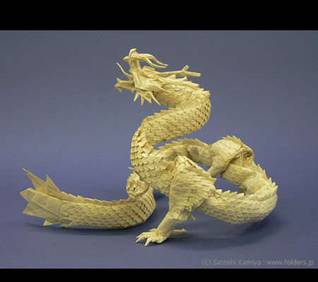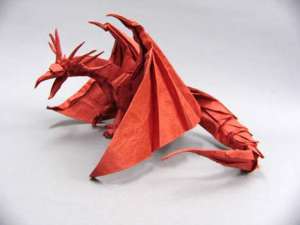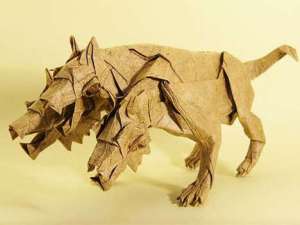Origami project symbolizes wishes for a better world
DANIELSVILLE – There’s a Japanese legend that promises a person who makes 1,000 paper origami cranes will have a wish granted by a crane – an animal that has supernatural powers in Japanese mythology.
Children in Madison County are working toward that 1,000-crane goal by the New Year and wish for world peace in 2010.
“This project is for everybody, but we decided to focus on children because, well, I would say the average child is for peace,” said Madison County Librarian Suzie DeGrasse. “When you get older, it gets all political.”
DeGrasse introduced the crane project to library patrons in October with hopes that the children who flood into the library each day after school would help create the flock of cranes.
She set out instructions and a stack of 8.5-inch square sheets of paper and offered to teach anyone interested in making a five-minute sculpture.
“I thought it would be fun for the kids, but it also gives them a big sense of accomplishment – first to have finished the crane and then also to contribute to such a large effort,” she said.
So far, children and a few adults have turned out about 200 of little paper birds.
Once kids are released from classes for the holidays, DeGrasse hopes the other 800 cranes will take shape quickly.
During the 20th century, paper cranes came to symbolize world peace because of the story of Sadako Sasaki, a young Japanese girl who was diagnosed with leukemia after the United States dropped an atomic bomb on Hiroshima at the end of World War II.
While Sasaki was in the hospital, she started making paper cranes as a symbol of her hope for peace and encouraged other children in the hospital to do the same. Her story inspired the crane as a symbol of peace in Japan and across the world.
DeGrasse will string paper cranes into garlands through the end of the year – using both cranes created at the library and those brought from home, she said.
For directions on how to fold a paper crane, visit the Madison County Library in Danielsville.
Eric Josiel’s origami sculptures are attracting thousands of euros
A Frenchman has set new standards in  the art of origami. Eric Joisel, who began to develop his skills when he lost his job as a printing company manager during the last recession, spends up to two weeks to create each figure and his work can sell for as much as €5,000 (£4,400).
the art of origami. Eric Joisel, who began to develop his skills when he lost his job as a printing company manager during the last recession, spends up to two weeks to create each figure and his work can sell for as much as €5,000 (£4,400).
A single scuplture takes up to three days to design and he might spend two more days to pre-crease the paper. “I then soak the paper in a substance containing glue and fold it while it’s wet,” he said.
Mr Joisel, 52, from Sannois, northern Paris, claims not to be appreciated at home. “I sell most of my pieces in Japan and America because Europeans see origami as being for children, but what I do is much more advanced.”
Many of his figures can be seen at ericjoisel.com, where he also offers instructions on how to make a hedgehog.
Madison No. 1 Middle School theater troupe to give origami to Japan
Symbolizing healing and peace around the world, more than 75 students and parents took time last week to fold squares of colorful paper into cranes. The goal of the community crane night at Madison No. 1 Middle School is to help the theater class make 1,000 origami cranes to send to Hiroshima, Japan.
For many of the adults, it was their first time making origami.
“I gave up,” parent Jill Kuefner said. “It’s a lot harder than it looks. But my daughter, she can make them out of Post-its.”
The crane night is tied to the school’s stage production of “A Thousand Cranes.” The play is about a young Japanese girl with leukemia who made hundreds of origami cranes.
This is the school’s second year having a theater class, teacher Melany Lange said.
Last year, the fifth- through eighth-grade classes performed “Alice in Wonderland” and “Peter Pan.”
“Last year felt like Disney,” Lange said. “Now it’s something meaningful. It’s really neat that it’s a true story and real and not a happy-go-lucky story. We might put tissue boxes in the aisles.”
Sadako’s story
Lange said students read “Sadako and the Thousand Paper Cranes” by Eleanor Coerr, and learned about Japanese culture, the atomic bomb and war.
Sadako Sasaki died Oct. 25, 1955. She was 12 years old.
Hiroshima Peace Park
Following the performance, the theater classes will send the 1,000 paper cranes to the park in Japan where they will be placed near the statue of Sadako. The Children’s Peace Monument is dedicated to the memory of the children who died as a result of the bombing.
Performance
6 p.m. Dec. 10, Madison No. 1 Middle School, 5525 N. 16th St. $2.
For information, 602-664-7199.
Origami Solar Cells
Silicon sheets self-assemble into spheres to capture more light.
One way to squeeze more power out of sunlight is to ensure that it always hits a solar panel at the ideal angle. This means either tracking the sun and maneuvering a panel to face it, or using complex optics to redirect the sun’s rays to hit the panel’s surface from above.
Researchers at the University of Illinois have now come up with self-assembling spherical solar cells capable of capturing more sunlight than flat ones. The shape is a simpler way to make more use of the sun’s rays, but has been difficult to realize in a solar cell. These new microscale solar cells are made using conventional lithography combined with self-assembly. If they prove practical, the devices could be wired up into large arrays that have the same power output as conventional cells, but that save on materials costs by using less silicon.
“Instead of a big slab of semiconductor fitted with concentrating lenses and motors to move it around, we want to make compact cells that still have a significant power output,” says Ralph Nuzzo, professor of chemistry at the University of Illinois at Urbana-Champaign.
Curved surfaces capture more light than flat ones because they have a greater surface area. But making solar cells that are curved or spherical is challenging, says Nuzzo, because the techniques used to process semiconducting materials such as silicon work best on flat surfaces. Nuzzo’s group has overcome this problem by making microscale 3-D structures that self-assemble from flat sheets.
The Illinois researchers start by treating the surface of a thin, high-quality silicon wafer and using conventional lithography to etch out a thin, two-dimensional shape. To make a sphere, the researchers cut the silicon into a flower shape. They then use an adhesive to secure a small piece of glass inside. The glass helps the structure maintain its shape once it is assembled. Finally, as a drop of water placed in the center of the flower shape evaporates, surface tension pulls its petals up, eventually bringing them together to form a sphere.
“The challenge in this is, how do you get things to follow the necessary sequence of steps to fold into the desired shape?” says Nuzzo. The Illinois group came up with mathematical models to help predict the mechanical properties of silicon sheets of different shapes and thicknesses, as well as how they interact with water, which can be tuned by chemically treating their surfaces.
Nuzzo’s group used the techniques to make functioning microscopic spherical solar cells, as a proof of the functionality of what he calls “materials origami.” Before cutting the silicon into the petal shape, the team treated it to form the conductive regions that make a solar cell work. After the flower had folded up into a sphere, electrical contacts were added. The group used a similar technique to make cylindrical micro-solar cells as well.
These devices convert only about 1 percent of the light that hits them into electricity–a poor return for a solar cell–but this is better than a planar solar cell made using the same relatively crude techniques using the same amount of silicon. The researchers say the technique can be applied to other materials besides silicon, and could be used to make new forms of solar cells. The work is described online this week in the Proceedings of the National Academy of Sciences.
“Folding is very appealing because you can make fantastic, complicated three-dimensional shapes,” says George Barbastathis, professor of mechanical engineering at MIT.
There are other ways of improving solar cells’ ability to capture light, such as antireflective coatings and surface texturing. The main advantage of the new approach is that it requires less material, says Nuzzo. Planar solar cells just a few micrometers thick can’t be textured–there’s simply not enough material. And antireflective coatings add more manufacturing costs and complexity. Self-assembly, Nuzzo hopes, could offer an alternative.
The Illinois group will now work to improve the process, and make designs that further improve the cells’ light management. “We want to bring forward form factors that rely on high performance materials like silicon but provide a substantial economy” by using as little of these expensive materials as possible, says Nuzzo.
Special thanks to http://www.topix.com
Perfect origami mushroom
Dave sez, “From the site of a group of radical origami artists called ‘Le Crimp’, here’s a fascinating video on making a near-photo-realistic mushroom from a piece of wrapping paper. Le Crimp was featured in the new origami documentary ‘Between the Folds’ showing on PBS stations in December .”
Intricate Paper Dragons – Satoshi Kamiya Makes Detailed Origami from Single Sheets of Paper
 We’ve featured some pretty fantastic origami over the years, but these pieces by Satoshi Kamiya are in a league of their own. He creates highly intricate sculptures from single pieces of paper, not missing a detail—he even included the individual scales on a dragon.
We’ve featured some pretty fantastic origami over the years, but these pieces by Satoshi Kamiya are in a league of their own. He creates highly intricate sculptures from single pieces of paper, not missing a detail—he even included the individual scales on a dragon.
This pictures only features a few of Satoshi Kamiya’s intricate works, but much more is on display at his website ; despite it being in characters foreign to me, it’s still easy to appreciate his incredible creations.
Origami mystery man rules the road in his deluxe home on wheels
 Imagine being an origami expert, folding dollar bills into intricate works of art. Now imagine that you’re also King of the Road, living in an amazing tricked-out truck boasting the best contemporary design and ultra-comfortable accommodations. Would that be a cool way to live, or what?! …
Imagine being an origami expert, folding dollar bills into intricate works of art. Now imagine that you’re also King of the Road, living in an amazing tricked-out truck boasting the best contemporary design and ultra-comfortable accommodations. Would that be a cool way to live, or what?! …
Origami project unites students !!!

Queen Bell likes the idea behind making origami cranes.”We can send peace to the world,” said Queen, a fifth-grader at Mineral Springs Elementary School.
Spotlight : Papercraft
Hello World !

Papercraft is the art of folding, cutting and manipulating paper into models and as such it can be very easy or be extremely difficult based on the project detail and size. For beginners, this blog will help you get the basics and start you moving in the right direction.




Recent Comments